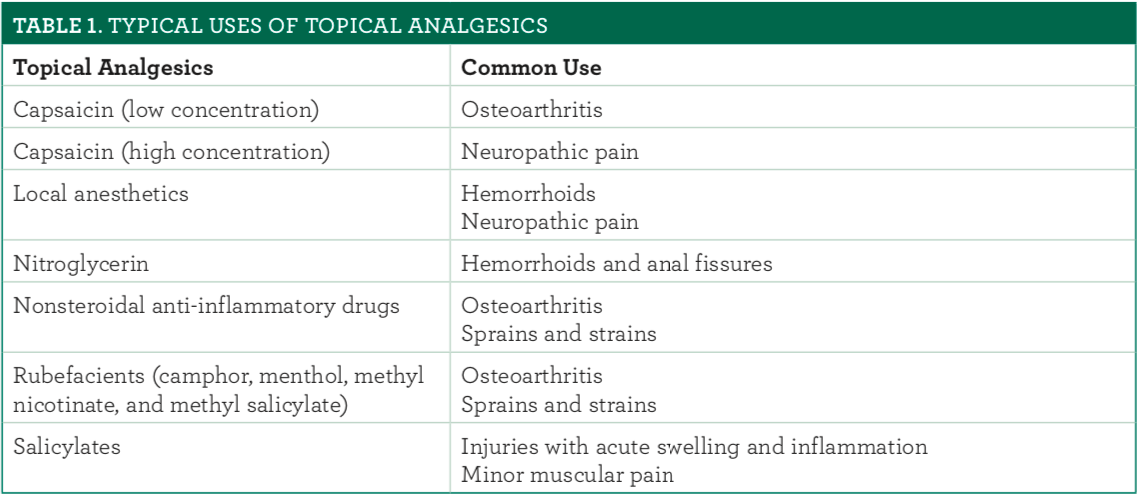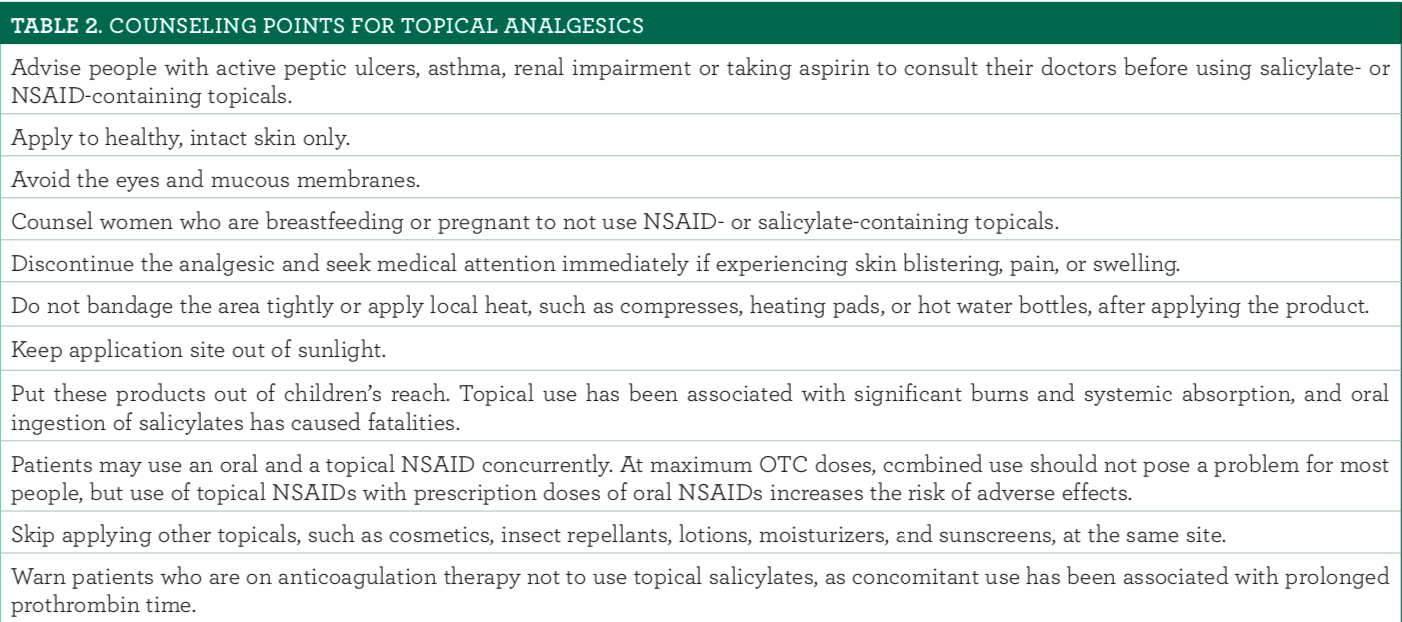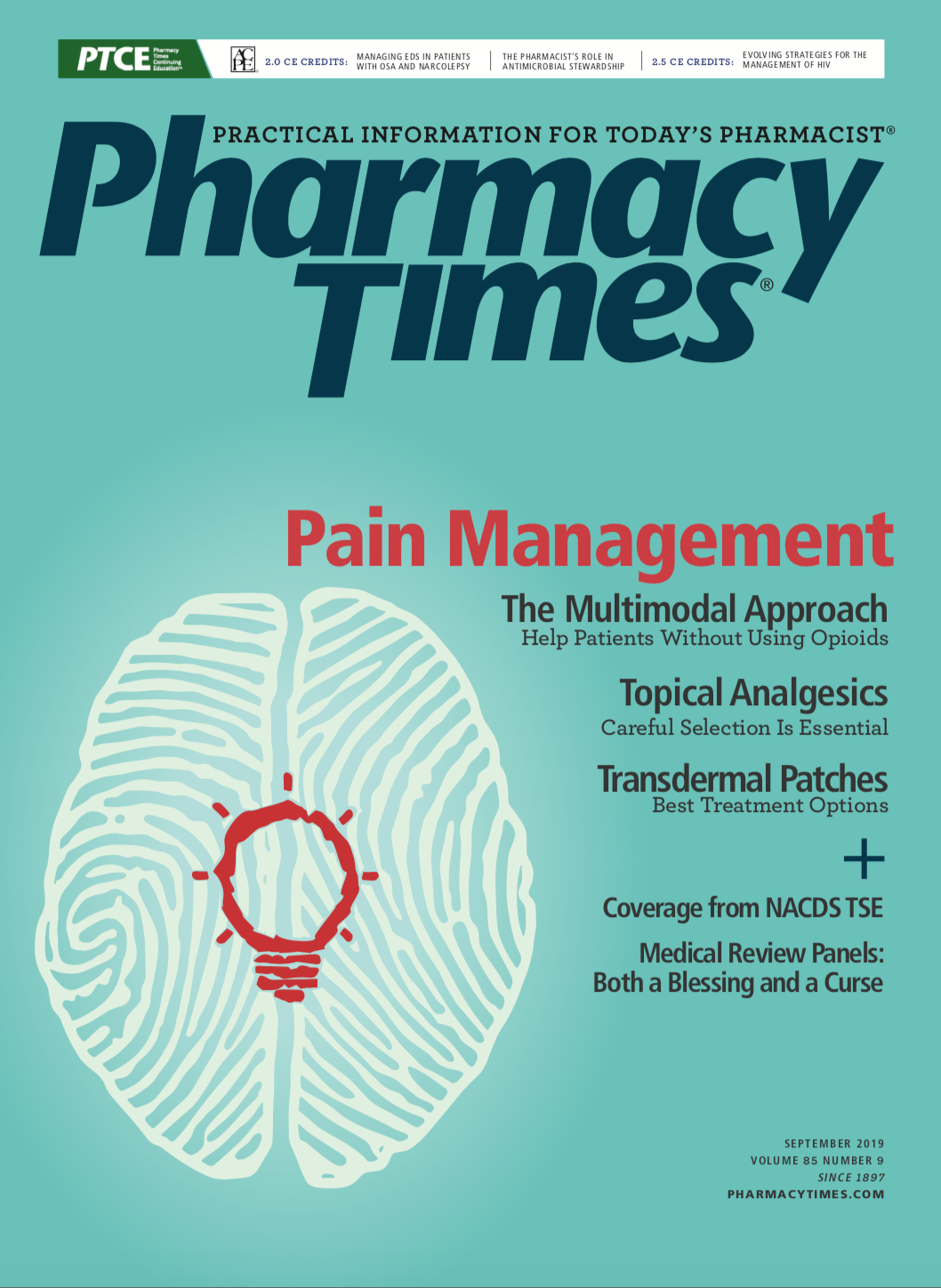Publication
Article
Pharmacy Times
Topical Analgesics Provide Pain Relief
Author(s):
Because of potential adverse reactions, careful product selection for both acute injuries and chronic conditions is key.
With greater emphasis now being placed on using the least addictive and most effective analgesics to treat pain and avoid opioids, topical analgesic drugs are experiencing a resurgence in popularity for certain painful conditions. They can be used for acute injuries, such as myalgia, sprains, strains, or tendonitis, or in the long term for neuropathic pain or osteoarthritis.
Numerous guidelines recommend topical analgesics for various conditions.1-5 A quick review of their limitations and strengths can help pharmacists make evidence-based recommendations for OTC and prescription products.
Most topical analgesics are provided as creams, foams, gels, lotions, or ointments and include capsaicin, lidocaine, nonsteroidal anti‐inflammatory drugs (NSAIDs), rubefacients (externally applied products that produce skin redness, including menthol and methyl salicylate), or salicylates (aspirin, magnesium salicylate, and sodium salicylate).
MECHANISMS OF ACTION AND USES
Table 11-6 describes common uses for specific topicals, which adults can apply to intact skin for pain. Theoretically, topical analgesics exert their effects close to the site of application and are associated with negligible systemic uptake or distribution. Individual drugs penetrate skin to different degrees, and some products include substances that accelerate skin penetration and boost tissue concentrations. Topicals are not transdermals, which lead to an intended systemic distribution. Patients and prescribers often choose these products to avoid system exposure. Creams are generally less effective than gels or sprays.6

DO THEY WORK?
The Cochrane Database of Systematic Reviews conducted a review of topical analgesics. It required at least 50% participant‐reported pain relief after appropriate durations.6 The study identified a number of products that appeared to be effective6:
- In acute musculoskeletal pain, diclofenac gel or plasters, ketoprofen gel, and piroxicam gel provided significantly more relief than the placebo. Adverse event rates with topical NSAIDs were about equivalent to those reported with a topical placebo. High‐concentration capsaicin tended to be associated with application-site pain.
- In chronic musculoskeletal pain (mainly hand and knee osteoarthritis), topical diclofenac and ketoprofen preparations provided significantly more relief than the placebo. Patients were least likely to withdraw from trials for lack of efficacy when diclofenac or salicylates were used. Adverse event withdrawals were higher with low‐concentration capsaicin (15%), diclofenac (6%), and salicylates (5%) than the placebo.
- In postherpetic neuralgia, topical high‐concentration capsaicin had limited efficacy for some patients.
This study found only limited-, low-, or very low—quality evidence of efficacy for other therapies. The researchers concluded that selection of the formulation used influences effectiveness in acute conditions, with gel seemingly more effective. Overall, they found that a small proportion of people experienced good pain relief.6
Other studies have reported good results with topical NSAIDs. One meta analysis found that 65% of participants who used a topical NSAID reported relief compared with 39% of placebo-treated participants.7
CONCLUSION
When used correctly for a short duration, topical analgesics are considered effective and safe. However, pharmacy staff need to be aware that they can cause adverse reactions. The FDA’s Adverse Event Reporting System database has identified numerous cases of first- to third-degree burns at the application site associated with OTC topical muscle and joint analgesics containing capsaicin, menthol, or methyl salicylate.8 The medical literature also includes many case reports.9-11 Severe blistering or burning often occurs within 24 hours of the first application. Products containing single-ingredient menthol or menthol/methyl salicylate with concentrations exceeding 3% and 10%, respectively, were more likely to cause more serious burns.11 Patients have also experienced burning with topical capsaicin.11 Table 28-10,12,13 summarizes counseling points for topical analgesics.

Jeanette Y. Wick, MBA, RPh, FASCP, is an assistant director of the Office of Pharmacy Professional Development at the University of Connecticut School of Pharmacy in Storrs.
REFERENCES
- Hochberg MC, Altman RD, April KT, et al; American College of Rheumatology. American College of Rheumatology 2012 recommendations for the use of nonphar- macologic and pharmacologic therapies in osteoarthritis of the hand, hip, and knee. Arthritis Care Res. 2012;64(4):465‐474.
- Osteoarthritis: care and management in adults. National Institute for Health and Care Excellence website. guidance.nice.org.uk/cg177. Published 2014. Accessed August 9, 2019.
- Attal N, Cruccu G, Baron R, et al; European Federation of Neurological Societies. EFNS guidelines on the pharmacological treatment of neuropathic pain: 2010 revision. Eur J Neurology. 2010;17(9):1113‐e88. doi: 10.1111/j.1468-1331.2010.02999.x.
- Finnerup NB, Attal N, Haroutounian Set al. Pharmacotherapy for neuropathic pain in adults: a systematic review and meta‐analysis. Lancet Neurol. 2015;14(2):162‐173. doi: 10.1016/S1474-4422(14)70251-0.
- Neuropathic pain in adults: pharmacological management in non‐specialist settings. National Institute for Health and Care Excellence website. nice.org.uk/guidance/ CG173. Published November 2013. Accessed July 3, 2019.
- Derry S, Wiffen PJ, Kalso EA, et al. Topical analgesics for acute and chronic pain in adults - an overview of Cochrane Reviews. Cochrane Database Syst Rev. 2017;5:CD008609. doi: 10.1002/14651858.CD008609.pub2.
- Mason L, Moore RA, Edwards JE, Derry S, McQuay HJ. Topical NSAIDs for acute pain: a meta-analysis. BMC Fam Pract. 2004;5:10.
- FDA. FDA drug safety communication: rare cases of serious burns with the use of over-the-counter topical muscle and joint pain relievers. www.fda.gov/drugs/ drug-safety-and-availability/fda-drug-safety-communication-rare-cases-serious-burns- use-over-counter-topical-muscle-and-joint. Published September 13, 2012. Accessed July 3, 2019.
- Rivard SC, Brelsford MA, Gibbs NF. Over-the-counter topical musculoskeletal pain relievers used with a heat source: a dangerous combination. Cutis. 2017;100(5):E22-E24.
- Morra P, Bartle WR, Walker SE, Lee SN, Bowles SK, Reeves RA. Serum con- centrations of salicylic acid following topically applied salicylate derivatives. Ann Pharmacother. 1996;30(9):935-940.
- Aspinall JB, Goel KM. Salicylate poisoning in dermatological therapy. Br Med J. 1978;2(6148):1373.
- Dickman A. Choosing over-the-counter analgesics. The Pharmaceutical Journal. November 1, 2008. pharmaceutical-journal.com/learning/learning- article/choosing-over-the-counter-analgesics/10040592.article?firstPass=false. Accessed July 3, 2019.
- Davis JE. Are one or two dangerous? Methyl salicylate exposure in toddlers. J Emerg Med. 2007;32(1):63-69.







